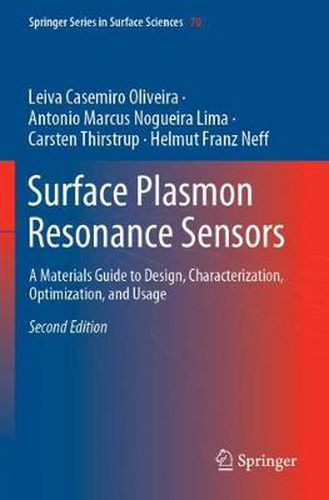Readings Newsletter
Become a Readings Member to make your shopping experience even easier.
Sign in or sign up for free!
You’re not far away from qualifying for FREE standard shipping within Australia
You’ve qualified for FREE standard shipping within Australia
The cart is loading…






This title is printed to order. This book may have been self-published. If so, we cannot guarantee the quality of the content. In the main most books will have gone through the editing process however some may not. We therefore suggest that you be aware of this before ordering this book. If in doubt check either the author or publisher’s details as we are unable to accept any returns unless they are faulty. Please contact us if you have any questions.
This significantly extended second edition addresses the important physical phenomenon of Surface Plasmon Resonance (SPR) or Surface Plasmon Polaritons (SPP) in thin metal films, a phenomenon which is exploited in the design of a large variety of physico-chemical optical sensors. In this treatment, crucial materials aspects for design and optimization of SPR sensors are investigated and described in detail. The text covers a selection of nanometer thin metal films, ranging from free-electron to the platinum-type conductors, along with their combination with a large variety of dielectric substrate materials, and associated individual layer and opto-geometric arrangements. Whereas the first edition treated solely the metal-liquid interface, the SP-resonance conditions considered here are expanded to cover the metal-gas interface in the angular and wavelength interrogation modes, localized and long-range SP’s and the influence of native oxidic ad-layers in the case of non-noble metals. Furthermore, a selection of metal grating structures that allow SP excitation is presented, as are features of radiative SP’s.
Finally, this treatise includes as-yet hardly explored SPR features of selected metal-metal and metal-dielectric superlattices. An in-depth multilayer Fresnel evaluation provides the mathematical tool for this optical analysis, which otherwise relies solely on experimentally determined electro-optical materials parameters.
$9.00 standard shipping within Australia
FREE standard shipping within Australia for orders over $100.00
Express & International shipping calculated at checkout
This title is printed to order. This book may have been self-published. If so, we cannot guarantee the quality of the content. In the main most books will have gone through the editing process however some may not. We therefore suggest that you be aware of this before ordering this book. If in doubt check either the author or publisher’s details as we are unable to accept any returns unless they are faulty. Please contact us if you have any questions.
This significantly extended second edition addresses the important physical phenomenon of Surface Plasmon Resonance (SPR) or Surface Plasmon Polaritons (SPP) in thin metal films, a phenomenon which is exploited in the design of a large variety of physico-chemical optical sensors. In this treatment, crucial materials aspects for design and optimization of SPR sensors are investigated and described in detail. The text covers a selection of nanometer thin metal films, ranging from free-electron to the platinum-type conductors, along with their combination with a large variety of dielectric substrate materials, and associated individual layer and opto-geometric arrangements. Whereas the first edition treated solely the metal-liquid interface, the SP-resonance conditions considered here are expanded to cover the metal-gas interface in the angular and wavelength interrogation modes, localized and long-range SP’s and the influence of native oxidic ad-layers in the case of non-noble metals. Furthermore, a selection of metal grating structures that allow SP excitation is presented, as are features of radiative SP’s.
Finally, this treatise includes as-yet hardly explored SPR features of selected metal-metal and metal-dielectric superlattices. An in-depth multilayer Fresnel evaluation provides the mathematical tool for this optical analysis, which otherwise relies solely on experimentally determined electro-optical materials parameters.